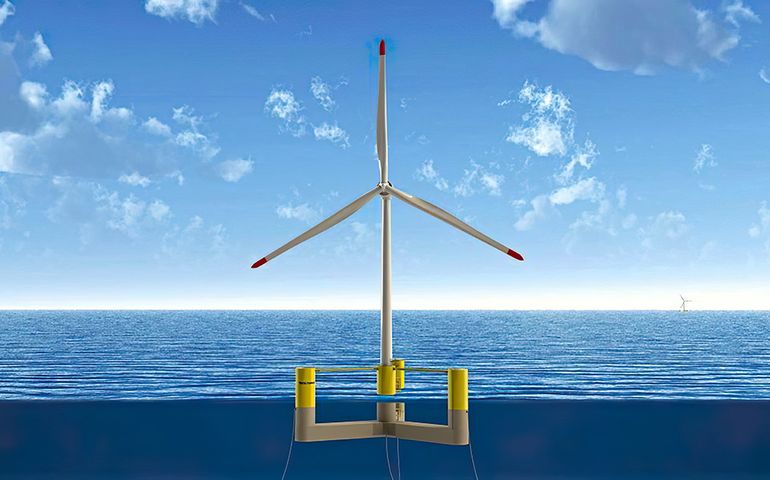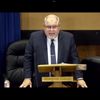
Feds advance state’s offshore wind development plan
 File Image
A rendering of a proposed turbine for the New England Aqua Ventus wind farm, which would be sited 20 to 40 miles off the Maine shoreline.
File Image
A rendering of a proposed turbine for the New England Aqua Ventus wind farm, which would be sited 20 to 40 miles off the Maine shoreline.
A research site for an offshore wind array in the Gulf of Maine has been advanced by the federal Bureau of Ocean Energy Management in the first project of its kind in the U.S.
The array could include up to 12 turbines placed on floating concrete platforms pioneered by the University of Maine. The lease is intended to allow researchers to study interactions of the array with the marine environment, fishing industry, shipping and navigation routes.
The Bureau of Ocean Energy Management determined that there’s no competitive interest for the 15.2-square-mile area of federal waters about 23 miles from Monhegan Island and 45 miles off Portland, according to a news release.
The decision doesn’t guarantee that the state will receive a lease for the project. The next steps for processing the application include a review of the potential environmental impacts from offshore wind leasing activities.
If the application is accepted, it could be used to inform any future commercial offshore wind development in the Gulf of Maine, as well as the deployment of floating offshore wind technology nationwide.

The final size and location of the research site will be determined by the Bureau of Ocean Energy Management during the lease review process.
“The research array is the cornerstone of Maine’s judicious approach to floating offshore wind, which emphasizes cooperation and collaboration with Maine’s fishing industry and environmental community to conduct important research and testing of this new technology and evaluate its potential impacts on existing uses,” said Dan Burgess, director of the Governor’s Energy Office.
The floating concrete hull technology to be used as platforms for the wind turbines have were designed and developed by the University of Maine’s Advanced Structures and Composite Center. The system is called VolturnUS.
If developed, the research site could generate up to 144 megawatts of renewable energy. To put that number in context, a megawatt of capacity will produce electricity that equates to about the same amount of electricity consumed by 400 to 900 homes in a year.
It would be the nation’s first floating offshore wind research site in federal waters.
The state applied for the research lease in October 2021, following months of public and stakeholder outreach, research and data analysis to identify a site in the Gulf of Maine with minimal effects on fishing, wildlife and navigation.
But Maine fishermen have registered their concerns about the project. Last summer, fishermen at a public hearing on the project said they were concerned about the potential effects of offshore wind power on their industry and asked the state to slow its development until there’s more research on the interaction between the two industries.
At 15.2 square miles, the site identified by the state represents approximately 0.04% of the 36,000-square-mile Gulf of Maine.
In the coming weeks, the Governor’s Energy Office said it expects to release the Maine Offshore Wind Roadmap, a plan for offshore wind in Maine developed by economic, environmental, fisheries, and community representatives over the past 18 months.
For more about the roadmap, click here.
Mainebiz web partners
Only a complete idiot living in neverland would believe for even a minute that an offshore wind farm makes any sense to anyone except the contractor who is getting paid tp build it. Wind farms are being abandoned all over the world as inefficient and incredibly unreliable not to mention an absolute nightmare for maintenance. Warren Buffet said it succinctly: "Were it not for the Federal subsidies [our tax dollars] these wind farms would make zero sense". This proposed boondoggle of waste will ultimately never be able to generate even 10% of the cost of the constriction & maintenance. Historically wind farms have a projected lifespan and if lucky MIGHT generate 25% of the electricity used to manufacture and erect it. Follow the money trail to see who is making the big bucks on this project and find out who they paid off to get here.
So obviously nobody from the government bothered to look up other offshore windmill projects to see that they are fine for a few years and then have all kinds of issues because they are made in China and not worth one quarter of what they cost. Other countries have tried it and never got to break even. But by all means, please spend my tax dollars on a worthless plan.













2 Comments